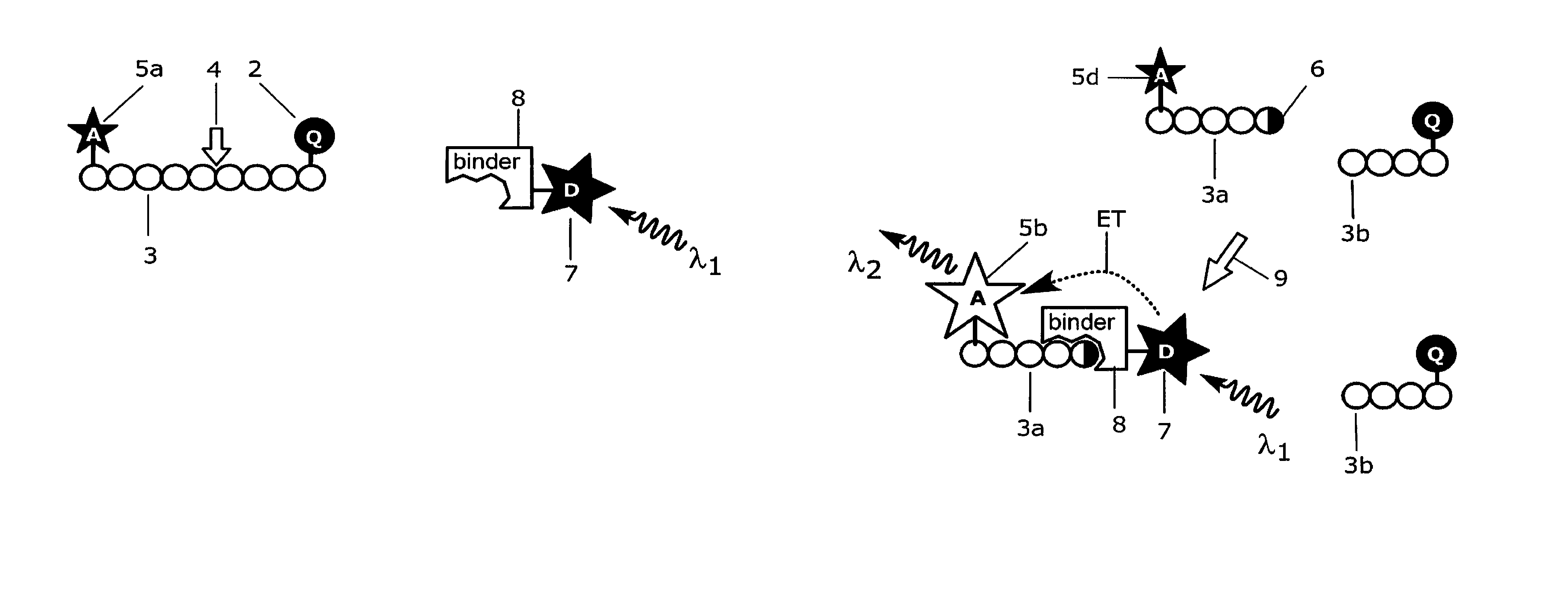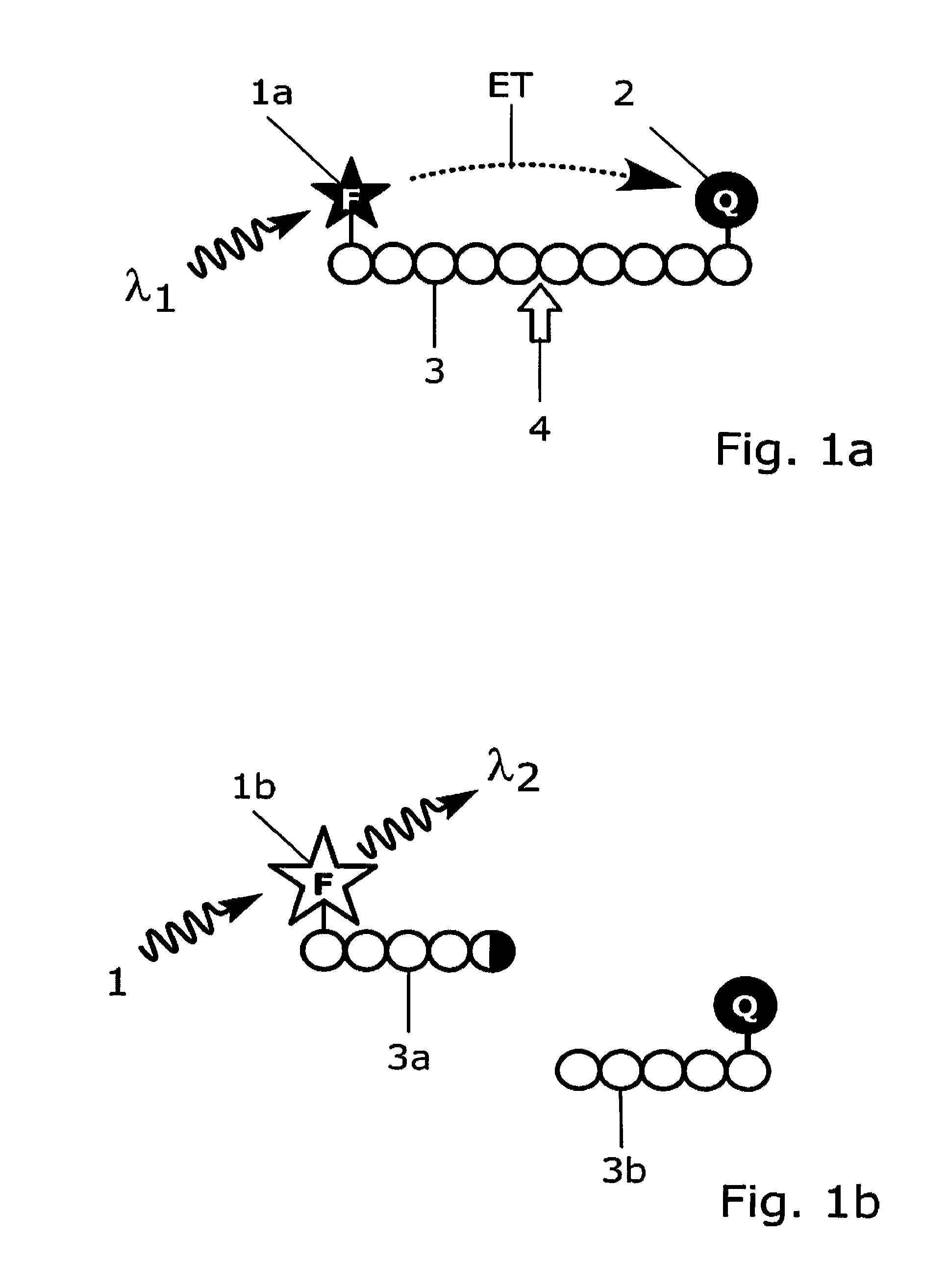Homogeneous luminescence bioassay
a bioassay and homogeneous technology, applied in the field of homogeneous luminescence bioassay, can solve the problems of limited further improvement of sensitivity, serious limitations of sensitivity, and significant increase of background signal, and achieve the effect of increasing the fluorescence of said acceptor
- Summary
- Abstract
- Description
- Claims
- Application Information
AI Technical Summary
Problems solved by technology
Method used
Image
Examples
example 1
[0179]Antibody 11H3 (0197-100 / bA4N-11H3, NanoTools Antikorpertechnik, Germany; indicated with label 8 in FIGS. 9a and 9b) that specifically recognizes the free N-terminal end of the amyloid peptide βA4 (indicated with label 6 in FIG. 9b) is conjugated to Europium(III)-chelate dyed Fluoromax nanoparticles (indicated with label 7 in FIGS. 9a and 9b) 92 nm in diameter, that is obtained from Seradyn Inc (Indianapolis, Ind.). The conjugation is done as described by Suokka, et al. Anal Chem 2001; 73:2254-60. Nanoparticles are prewashed with 10 mmol / l phosphate buffer, pH 7.0, on a Nanosep microporous centrifugal filter (300 kDa cut off; Pall Filtron, Northborough, Mass.). Phosphate buffer is added to the particles, and the solution is sonicated with a tip sonicator (Labsonic U; B. Braun, Leverkusen, Germany) at 80 W for 5 s. Carboxyl groups on the surface of nanoparticles are activated with 10 mmol / l N-(3-dimethylaminopropyl)-N9-ethylcarbodiimide and N-hydroxysulfosuccinimide (Fluka, Buch...
example 2
[0186]The anti-amyloid peptide 134A antibody 11H3 (indicated with label 8 in FIGS. 9a and 9b) is labelled with fluorescent europium chelate labelling reagent {2,2′,2″, 2′″-{[2-(4-isothiocyanatophenyl)ethylimino]bis(methylene)bis{4-{[4-(α-ga-lactopyranoxy)phenyl]ethynyl}pyridine-6,2-diyl}bis(methylenenitrilo)}tetrakis(ace-tato)}europium(III) (von Lode P et al., Anal Chem 2003; 75: 3193-201; indicated with label 7 in FIGS. 9a and 9b). The labelling of antibody 11H3 is performed in 50 mmol / l sodium carbonate buffer, pH 9.8, using 50-fold molar excesses of the chelate labelling reagent. The reaction is carried out overnight at room temperature and the excess free labelling reagent is removed on NAP-5 and NAP-10 (Amersham Biosciences) chromatography columns using Tris-saline-azide (6.1 g / l Tris, 9.0 g / l NaCl, and 0.5 g / l NaN3), pH 7.75, as elution buffer. The fractions containing the antibody are collected and the europium concentrations are measured against a europium calibrator using D...
example 3
[0188]An assay according to the present invention for the detection of calcium binding related conformational changes in calmodulin was developed (FIGS. 8a and 8b). For the assay, a dual-labelled human calmodulin (indicated with labels 3 and 3c in FIG. 8a) is produced by labelling the amino terminal and carboxy terminal domains of calmodulin with QSY35 dye acting as a quencher compound (indicated with label 2 in FIGS. 8a and 8b) and with Cy5 dye acting as an acceptor group (indicated with label 5a in FIGS. 8a and 8b), respectively. The labelling strategy is adapted from Lang et al., Anal. Biochem. 2005, 342: 271-279, and involves targeting of the first dye to free thiol group of a cysteine engineered to the surface of the protein and the other dye to an engineered selenomethionine residue. For labelling, engineered calmodulin containing mutations threonine 34 to methionine and threonine 110 to cysteine is constructed by site-directed mutagenesis as described by Lang et al., (Anal. B...
PUM
| Property | Measurement | Unit |
|---|---|---|
| diameter | aaaaa | aaaaa |
| diameter | aaaaa | aaaaa |
| diameter | aaaaa | aaaaa |
Abstract
Description
Claims
Application Information
 Login to View More
Login to View More - R&D
- Intellectual Property
- Life Sciences
- Materials
- Tech Scout
- Unparalleled Data Quality
- Higher Quality Content
- 60% Fewer Hallucinations
Browse by: Latest US Patents, China's latest patents, Technical Efficacy Thesaurus, Application Domain, Technology Topic, Popular Technical Reports.
© 2025 PatSnap. All rights reserved.Legal|Privacy policy|Modern Slavery Act Transparency Statement|Sitemap|About US| Contact US: help@patsnap.com



